Andi Fischer and Franz West
Some Reflections on Deskilling and Disorientation in the Works of Andi Fischer and Franz West
By Johannes Hoerning
Published in FEST – Andi Fischer & Franz West, exhibition catalogue, organized by APlus Gallery and Daniel Lippitsch, Schaulager Wien, Vienna (May 28 – July 18, 2021)
“…a play with one’s own arrogance.”
Franz West, 1989
“Nothing has to endure more stupid remarks than a painting.”
Pierre Bourdieu (after Edmond and Jules de Goncourt), 1999
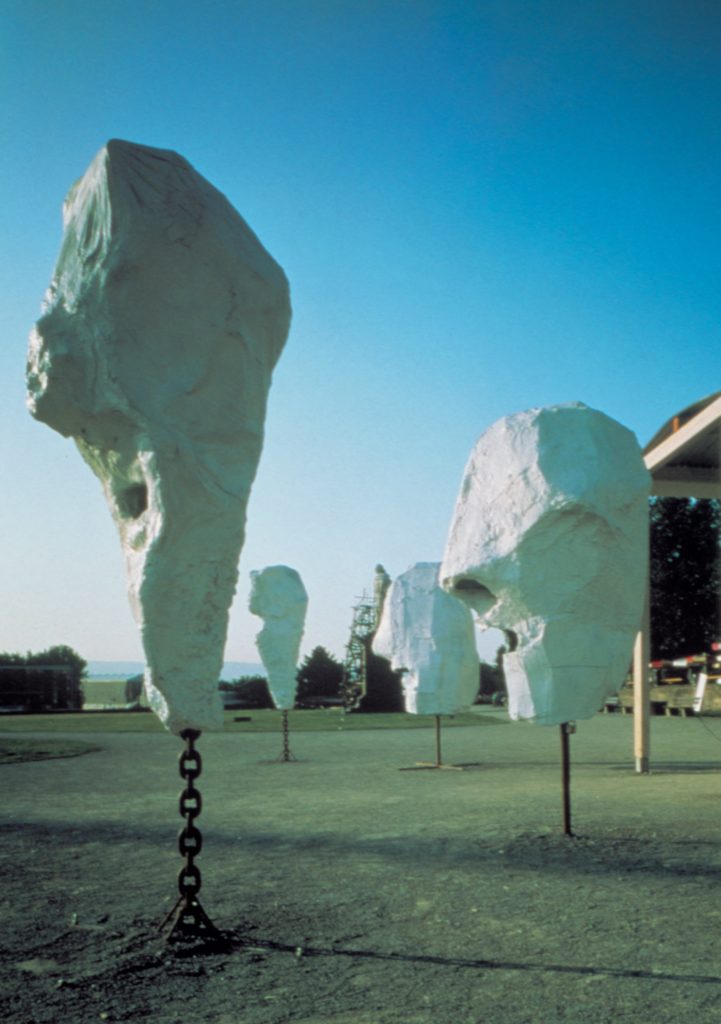
Interpretative and speculative possibilities abound whenever two artists are exposed to one another during their lifetimes or posthumously. This is especially so when the artists in question have had no known personal contact, which would allow for secure points of reference for reading their work based on correspondences, collaborative efforts, or the testimony of common friends. Neither, in our case, was the one the late teacher of the other, so that he could have left his mark on the younger’s formative years. Taking this negative reality as a point of departure, the question arises how we ought to approach the works of Andi Fischer (b.1987) and Franz West (1947-2012), now that there are shown together for the first time in Vienna? The city itself is a significant location, to be sure, one on whose cultural history West left deep and lasting marks. But making a fetish of a location (like with any other category of analysis) produces its own side effects, especially in the case of Vienna, about which West like so many other artist and writer colleagues had always had an ambiguous relationship, to say the least. It might also be tempting to take the work of the later born, Andi Fischer, and seek in his works confirmation of representative elements hiding somewhere in West’s capricious body of work, which in this current exhibition covers three decades, from his early gouache works and collages of the 1970s, an early object entitled Maulschelle (1980), a Telefonskulptur (1993), to his late object Pleonasme (1999). But this pedantic-didactive exercise in excavation and projection is an oddly limiting one, relying on educated guessing and on little more than Fischer’s (and our) questionable advantage of having so far outlived Franz West.
The routinely discussed psychosexual allusions in West’s collages, performances, and sculptures might be locatable in Fischer’s work if one submits his so-called “childlike figuration” to a Freudian reading. Yet, psychosexual readings of cultural production always say too much or too little, simply because with some stretch of the imagination every work of creative human production lends itself to applied psychoanalytic theory; one may well engage in such psychoanalytic effusions without ever saying anything that is of aesthetic relevance for the objects under consideration. In other words, one needs to explain and justify how one mounts familiar theory onto aesthetic objects or how one reads off such theory from aesthetic objects. That West read and discussed Freud is hardly reason enough. A closer look at his work would, in any case, reveal a thoroughly fragmented interest and referencing of both philosophy and psychoanalytic theory, rather than a systematic reconstruction with any effort toward theoretical cohesion.
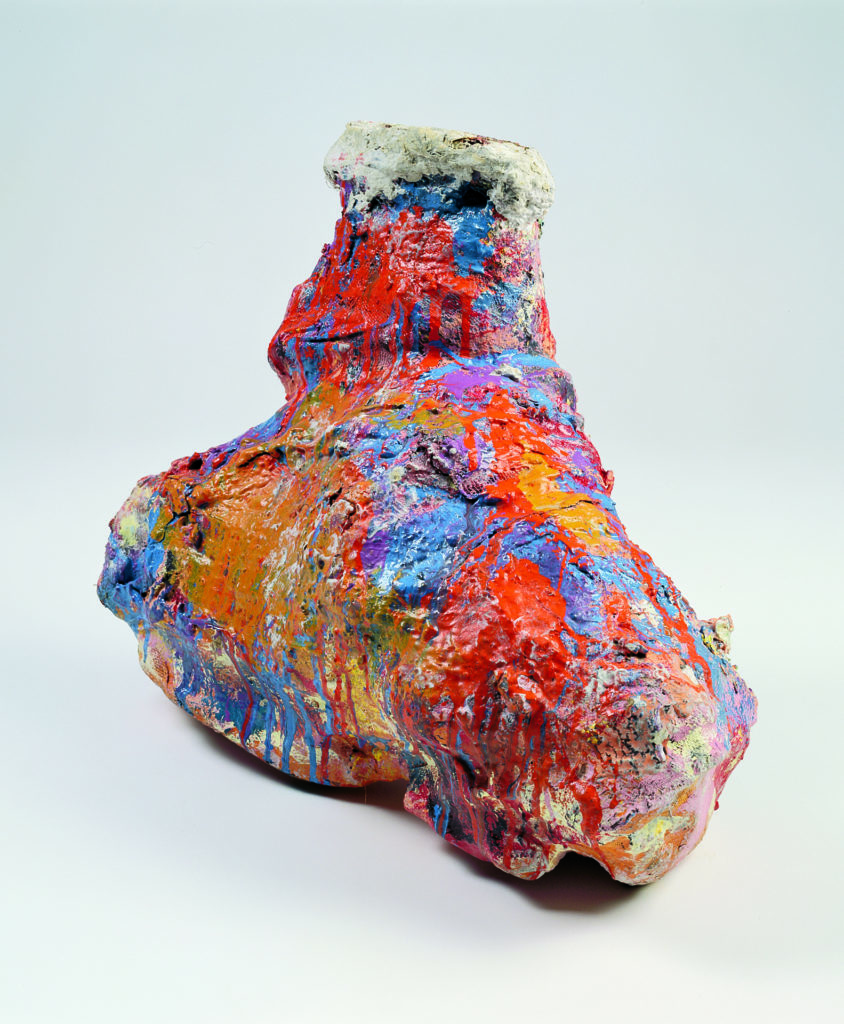
For all we know, Fischer did not make works about West or with West in mind, in the same way that West would do repeatedly with Cy Twombly as early as 1980 and still in 2009, culminating in West’s musical event composed for Twombly’s retrospective at MUMOK. “When you bear someone in mind like this,” explained West, “it leads to a kind of ‘internal logic’ that influences the resulting forms, or even creates them – it’s an analog relationship […]” [1] The outcome of this analog relationship might well have led West to not becoming a painter, for he acknowledged how Twombly had transformed painting to such a degree that there would be no need, or indeed, that it would not be possible for painting to receive any further articulation worthy of West’s artistic attention. Fischer’s relationship to West and West’s relationship to Fischer must therefore find a different point of orientation. If we want to get further into their practice and see what kind of effects the works in their relationship to one another accomplish and mutually amplify, we should begin by considering the strategy that I, for one, believe is common to their artistic production but has so far been neglected in discussions of their work: the strategy of deskilling.
Deskilling, as is well known, denotes a “persistent effort to eliminate artisanal competence and other forms of manual virtuosity from the horizon of both artistic production and aesthetic evaluation.” [2] Fischer and West employ precisely such effort. Its historical beginnings are difficult to determine because deskilling is a relational term contingent on what artisanal competence has come to mean at particular times. Any artist who decides to employ deskilling, in other words, responds to skilful competence or style as a normatively established and therefore historical notion, embedded in and legitimized by the social, political, and cultural order of the day. If we had to name one of the earliest instances of deskilling in art, then it might well be in the work of the ‘radical’ boulevardier Manet. [3] He had taken a great deal of interest in class conflict and civic displacement, especially in the work of the 1860s, the same decade in which the term “capital” had begun to circulate, which his older contemporary Marx would theoretically memorialize in Das Kapital, published in 1867. [4] That deskilling was part of Manet’s “symbolic revolution,” to use Pierre Bourdieu’s term, is the reflection also of a reality of deskilling of labour and the replacement of manual skill by machines that had set in rapidly as an upshot of the earlier industrial revolution (in England, where Marx lived much faster than in France, of course). And while the normative integrity of Manet’s “symbolic revolution” (Bourdieu) for the aesthetic realm is gone – compromised, co-opted, commodified, you name it – the strategy of deskilling remains available as long as skill retains cultural validity and deskilling of labour remains economically relevant under advanced capitalism. For Manet and Marx alike, then, despite their radical differences, the loss of skill was not something to bemoan. The question was and still is, as we debate the impact of AI today, who benefits from technological progress and under whose control are the de-skilled means of production? For that reason, the strategy of deskilling continues to capture a shared social condition, all the while producing similarly estranging effects among bourgeois audiences, who, roughly two hundred years after its earliest deployment, still often see their faith in skill and merit offended by it. For deskilling to be grounded in distinctly anti-bourgeois aspirations, at the service of the proletariat, it had taken the more overtly political dimensions of Suprematism, Constructivism, or some communist instances of Surrealism, tendencies which succeeded, as we know, only momentarily and failed in all their political ambitions. It took Duchamp’s readymade to introduce the most dramatic form of deskilling, which disavowed not only skill but artistic authorship by presenting an act of selection of an object of non-artistic labour as one that ought to be regarded as a work of art. Once inaugurated, the strategy of deskilling proved resilient in its potential for renewal, receiving currency after the war as a reaction to Abstract Expressionism by artists like Jasper Johns and many others, albeit by then, deskilling would become irredeemably imbricated with exchange value, a lasting elective affinity well into the present and likely into the future.
Franz West once remarked that for him philosophizing is like jogging, something he does as an amateur, as he pleases, and without a particular end in mind, which would be expected, perhaps, from a professional philosopher or athlete. Not even here, then, are competence or know-how taken to be a requirement, nor are they modelled on ideals of performative success. They aren’t even desirable. According to Friedl Kubelka, Franz West, for his part, early on used the word “künsteln” to describe his practice, which has been explained as “amateurish tinkering in the studio that refuses to be taken seriously.” [5] By West’s own standards, then, calling him a professional artist would be a misnomer. And what else is this künsteln but a strategy of deskilling? And we are not wrong, I believe, to see in Fischer’s erratic and, precisely for this reason, parodic execution of recognizable imagery in oil stick a similar kind of künsteln or amateurish tinkering.
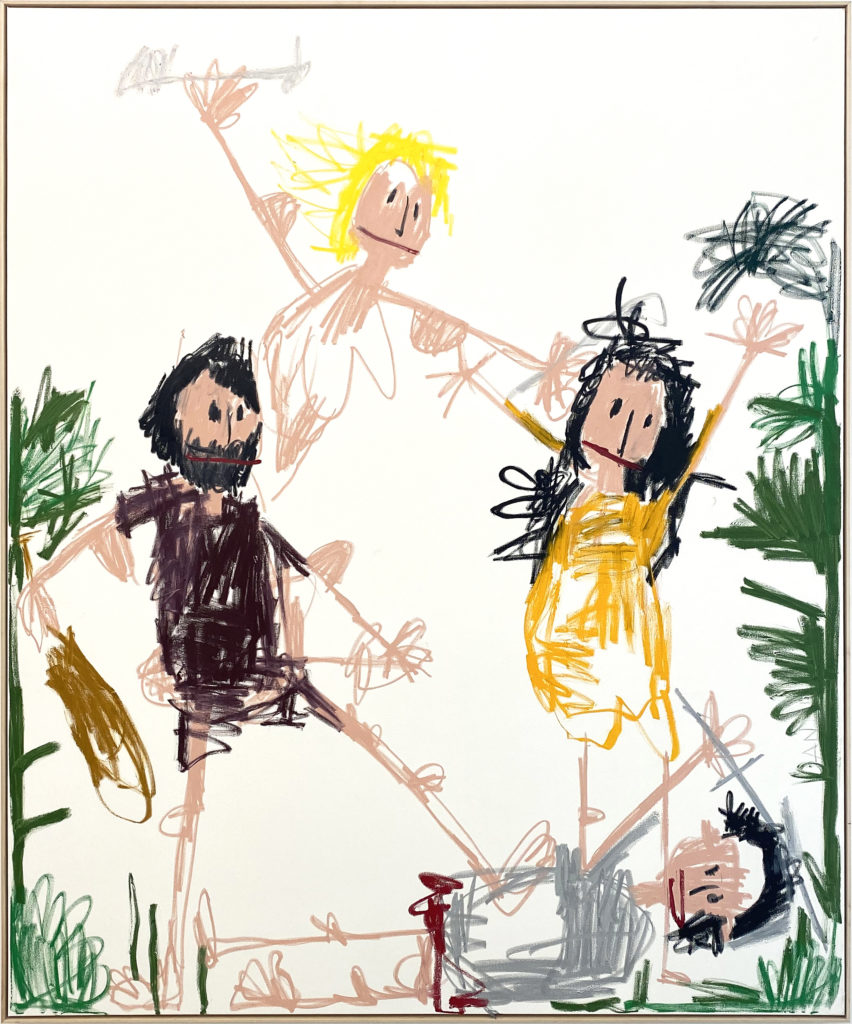
Fischer’s reduced chromatic ordering only occasionally surpasses primary or secondary colours and his entire inventory of animals and human figures appears in the same chromatic range, altered only for narrative purposes, when his figures wear knightly armament or other fabrics, as in his latest canvases IMMERNOCH REIBEREI (2021) or HERKULES EINE GEWISSE ANSPANNUNG WAR ZU SPÜREN (2021). This representation of armament or clothing, like anything else in Fischer’s work, is reduced (mono)chromatically and entirely free of shimmering effect or wrought textures. His over-simplification of spatiality and reduction of colours leaves no room whatsoever for the auratic appeal that skilfully crafted surfaces and textures would produce or are intended to generate in the viewer. In stark contrast to Fischer’s reductive approach, the skilful crafting of textures seem to have lost little of their magic appeal for painters and sculptors of the recent past and present, especially when such surfaces are instrumentalized as relics of the past or tokens of the alien (cases in point are Anselm Kiefer or those artists working in the painted collage tradition of Dali or Magritte). This non-auratic or anti-auratic dimension of Fischer’s flat surfaces produces instead of aura a sense of awkwardness, as one might call it. This awkwardness is amplified by the sense of presence of an author, who is entirely bereft of aesthetic mastery or virtuosity. Isabelle Graw has called this effect particular to painting the “ghostlike presence of the absent author,” [6] which in the case of Fischer (and indeed of West) we could modify to the “ghostlike presence of the absent author as amateur.” That very absence, by the same token, has nothing auratic or hagiographic about it. Unlike the artist as genius, the artist as amateur suggests replaceability, one that is challenged perhaps only by repetition of motifs and colours, which appears to reintroduce skill or competence at a level hardly worthy of their conventional understanding. That Fischer introduces the most banal of onomatopoeic elements into his all caps titles such as JA JA JAGD (2019) or KROK ADA EIN ENORM BERG + HAUS (2021), or that he creates dyslexic distortions such as SCHLONGÄ DURST (2021) offers additional commentary on any ambition to recreate mythical reality through historical citation either visually, linguistically, or both.
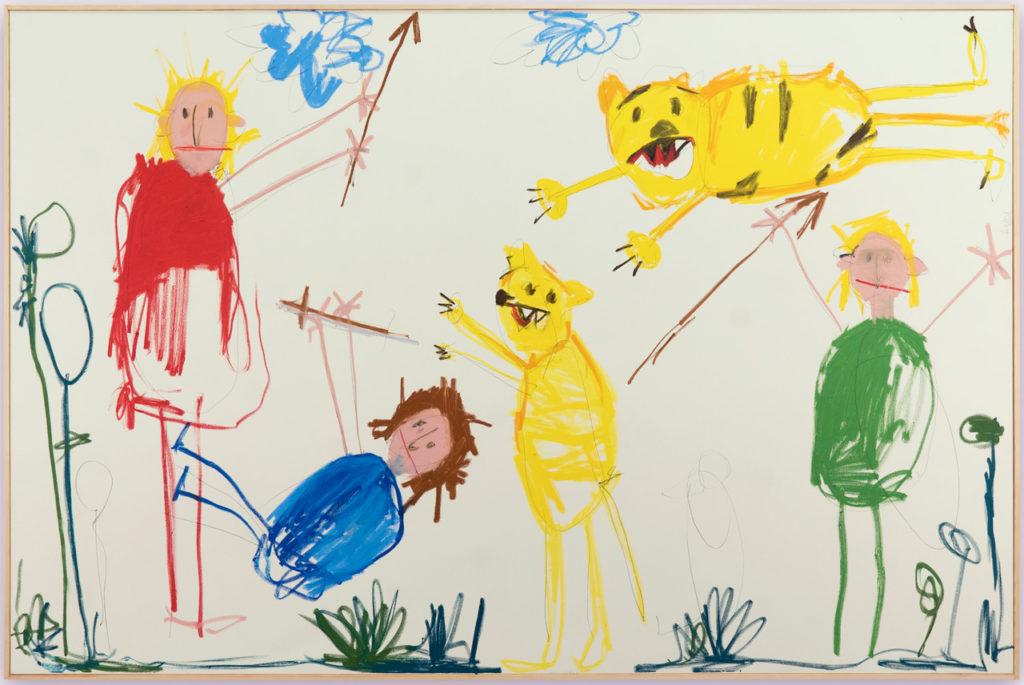
While the deskilling strategies of prewar monochromatic efforts and of some of their post-war iterations often sought to erase subjectivity in their work, neither West nor Fischer seem interested in such undertakings. But where their subjectivity is preserved, or even where it is prized in expressive and gestural elements or informal signatures like “ANDI,” in the case of Fischer, such subjectivity appears entirely lowered to the common denominator of the capacity for human agency or, to use another German painter’s way of putting it, expresses (especially in Fischer’s case) “that painting is one of the most basic human capacities.” [7] In its idealized form, this capacity denotes the ability to act freely and self-determinately, without however attaching any particular qualitative attribution or normative expectation – merit or virtue – to the outcomes of such capacity; an egalitarian and anti-meritocratic dimension, if one cares to put it this way. What this means for the audience of Fischer’s and West’s works is that any specialist knowledge as a requirement for competent reception is anathema. For how could the artist as amateur expect the audience to base aesthetic experience on learned skill or even moral principles? That one become an expert and competently relate aesthetic experience of works of art to one’s own aesthetic and moral principles presents the kind of bourgeois attitude that West’s fellow Austrian writer Robert Musil once caricatured so well in the figure of Graf Leinsdorf, who was entirely unable and unwilling to see in works of art, as Musil put it, “etwas anderes als Übereinstimmung oder irrende Abweichung von seinen eigenen Grundsätzen” [8] (anything other than confirmation or confusing digression from his own moral principles.) That this sort of moralizing attitude toward cultural production has remained prevalent among audiences of all kinds is perhaps the best indicator that strategies of deskilling shall retain their confrontational relevance, despite the obvious fact that such strategies have often eough become a commodified cliché, whose practitioners no longer care all too much to break the link to high-art practice.
Issuing from the afront against ‘competent’ reception and anything auratic, Fischer’s interest in historical and mythological genre painting is particularly interesting for an age such as ours with amplified production of nationalist rhetoric and display of state power, subtle or not so subtle. For aura sits unwell not with deskilling per se (any Rothko is highly auratic and deskilled) but with deskilling whose motivation is set against the reconstruction of pure aesthetic experience, historic authenticity, or mythological sway. While Fischer’s work, then, may well serve as a reminder that all elements of historical genre paintings and mythological imagery have become entirely obsolete in themselves and wrenched from their initial functions at the service of dominant power, one must still look elsewhere to find the same ideological needs satisfied, which these former modes of expression had done so well and so eagerly. The nation state and its myth, after all, have not disappeared, nor then has the need for their cultural legitimation and their claims to historical validity. Though this can no longer (or only uneasily) take place via the appropriation of historical icons, the worst of which are beheaded in an ongoing fashion, rather, once these icons have been dethroned, the iconic gap must be filled somehow and by someone. While Fischer’s deskilled figuration reminds us, contrary to the works of someone like Markus Lüpertz, of the obsolete representational role of historical icons and myths, representational roles in themselves are not obsolete just that they take different forms in different ages – Staatsmalerei (state-painting) has many heads fit for decapitation.
A similar handling (or intentional mis-handling) of historic-mythological source material for the sculptural realm and its appearance in the public sphere may be discerned in West’s monumental Lemurenköpfe (first shown at Jan Hoet’s Documenta 9, 1992), as well as in the title of one of his later series Sisyphos (I-X) from 2002, large papier-mâché bodies filled with rubbish and covered in industrial paint splashes. His most consequential approach for the strategy of deskilling, however, remains West’s active involvement of his audience beginning around 1973-74 with the creation of his Passstücke or Adaptives. A little later, a circular-shaped variation would be titled Erstes Passstück in 1978. Passstücke require an audience, any audience, to enliven the work and activate it. That all these objects are made for unspecific use exposes the impossibility of mastering a certain way of using, looking at, or handling them. While deskilling marks the strategy of their intentionally sloppy material production, often incorporating quasi-readymade detritus, users of these objects are themselves bereft of skill (in the form of specialized knowing how) as an aid for access to the works, simply because lack of instruction leaves all participants equally inadequate (or equally adequate). West had thereby turned the relational dimension of deskilling from indeterminacy of viewing/interpreting to unpredictability of performance, amplifying his disavowal of competence as achievable virtue whenever viewers encountered these objects. While the act of deskilling in Fischer lies in the invisible act of painting in the studio, as it were, and therefore finds expression in a final object, in West’s case, the act of deskilling is extended to participation. Merit, or some such metric to determine who is and who isn’t eligible for participation was anathema to West, an attitude which he would translate also into installations such as Eo Ipso (1987) in Münster, for which the public was simply invited to take a seat; on a larger scale such ideas were reiterated in Auditorium, 1992, an installation of 72 divans with cushions also at Documenta 9. Here, West had taken on ideas close to American Fluxus artists such as George Brecht, who showed his last public sculpture “Three Void-Stones” (1987) also in Münster, and who, earlier in 1959-62, had turned the most ordinary of sounds, dripping water, into a collective sound act. West had turned the act of sitting into something similar: an action for which no skill whatsoever is required, and an action which does not hang onto some sense of auratic subjectivism, known still from Wiener Aktionismus, but rather replaces it by way of an egalitarian gesture. Veit Loers once described West’s attitude as “egalitarian gallantry,” [9] although the gallantry part of this expression sits unwell with deskilling, as I discuss it here, unless one understands gallantry parodically or unless one detects in egalitarian strategies as such elements of deskilling.
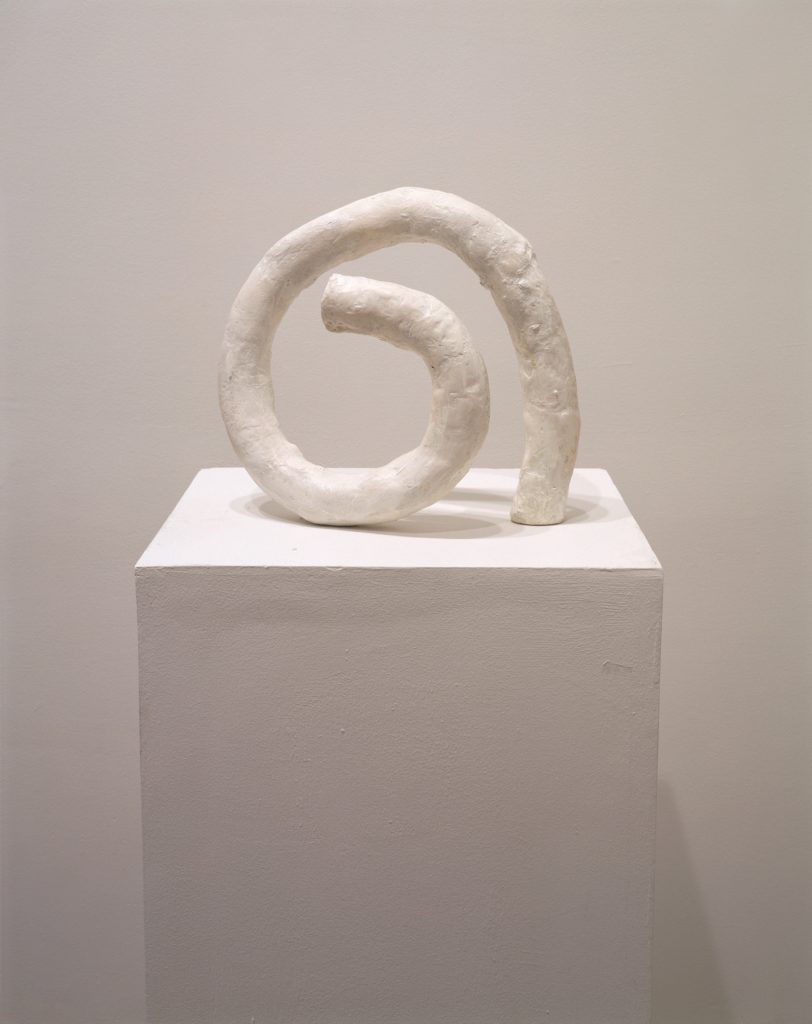
Somewhat extending the logic of Passstücke, West’s small series of Telefonskulpturen executed around 1993-95, had combined two otherwise unrelated activities: ordinary communication in the studio and intentional artistic (or tinkerish) production. These works got their name from serving West and others in the studio as objects fit for modification during phone calls by way of further deformation or random coloring. The obvious reference for West’s concerns with cross-labour and cross-activity objects are Laszlo Moholy-Nagy’s series of Telefonbilder from 1922/3. Moholy-Nagy had ordered these identical paintings, varying only in size, from an enamel factory south of Weimar to prove right Malevich and El Lissitzky’s claim that “one can do no better than order one’s paintings by telephone from a house painter while one is lying in bed.”[10] This invitation of lying in bed and, perhaps, getting something out of it must have been very much to West’s liking, although his point was less to merely include anonymous and non-artistic labour into his work, but rather to see what happens, or what doesn’t happen, when ordinary, unplanned activities in the studio coalesce with sculptural production.
The acts of lying around or sitting around had been no less important for West, activities which from his first furniture pieces in the later 1980s to his Seating Masses (Sitzwuste) would remain part of his practice. In all his furniture installations West had taken George Brecht’s logic of collective action further by disavowing attachment to specific outcomes for which at least a modicum of discipline and some level of instruction would be required, as was evident in Brecht’s minimal but no less instructive “event scores,” written for performers. It was none other than Brecht’s colleague Alan Kaprow, who sometimes got frustrated at the audiences’ violation of his instructions and it was Kaprow, too, who delivered a lecture in Vienna in 1970, attended by West, leaving the young artist “impressed with the idea of using items of practical use in an unusual context.”[11] West’s fascination with Kaprow did not also encourage him to later write instructions in order to direct his audiences. West could not have written such scores to begin with, since no particular action was ever expected of the viewer as participant. For him, artistic action had no determinate criterium for success.[12] As West explained, “the performance isn’t necessarily worse when it works rather than when it doesn’t.”[13] Although to some degree working in the shadow of Brecht’s and Kaprow’s conceptual turn in late 1950s and 60s, West had chosen to give up the authorial need for direction and control and was therefore able to break free from the more constraining elements of Fluxus.
Fischer, too, in a first series of wooden cabinets, begins to introduces participatory action as an element in his practice and therefore, like Brecht and West before him, has come to internalize Duchamp’s insistence from a 1957 lecture that “the creative act is not performed by the artist alone.”[15] Although still restricted by glass and with limited range of motion built into the objects, these cabinets suspend what often appears rather accidental in his paintings: the positioning of figures and objects, distorted as their outlines are through erratic application of oil stick. Fischer’s inventory of miniature wooden objects appears now more conscientiously, almost pedantically, placed within these cabinets. Such oriented placement, however, does not also revert Fischer’s deskilling strategy but rather amplifies it, especially when contrasted to the neat crafting of the plain wooden cabinet; an object with a singular function, which might well be used for any other kind of collectible object someone cares to display. Here, Fischer invokes obvious links to the culture of accumulation but instead of reiterating the readymade logic from Arman, to Brecht or Hirst, Fischer reflects instead on the construction of singular narratives or singular courses of action within narratives. What happens in these cabinets is broken down into fable-like sequences of those over-simplified elements we find also in his paintings. In their three-dimensional variation, however, Fischer might be taken to free these same elements to the degree that the miniature objects suggest the possibility of deliberate re-arrangement. Yet, any such rearranging would not greatly change the duality of action/reaction that obtains between a tiger and trees, a crocodile and a house, a falcon and a snake. Even more so than in his gesturally distorted canvases, it is in these three-dimensional scenes that Fischer’s narrative reduction stands out without, however, putting this reduction at the service of a didactic mission known from fables or parables of the Aesopic or rabbinic kind. The familiar comparison of two elements in the parable genre has served not only basic elementary schooling since ancient times but also argumentative purposes and the construction of a prudential lesson most often oriented toward moral truths that are taken to be universally applicable. It is, perhaps, this appeal to universality linked to what I have earlier called the capacity for human agency as a common denominator for Fischer’s painterly and now sculptural practice, which we find in concentrated form in his cabinets. But, again, despite some viewer’s wishes to the contrary, the formal concentration of objects and narration does not also provide didactic-moral orientation.
Lack of orientation, to be sure, is not the same as disorientation, although perhaps close enough in its ability to raise questions about the purpose of artistic production or the role of the artist. West often remarked that he was in a state of disorientation, one that ought not be understood negatively, but as a welcome fact of how he regarded his artistic production and, more importantly, one that he wanted to translate into his audience’s experience of his objects. The way language was introduced into conceptual art by Brecht or Kaprow had not the function of disorientation. Neither was disorientation their goal. Their events or performances provided a form of engagement, which these artists thought painting or sculpture alone could not achieve, requiring the viewer instead to act as the subject of a language game with somewhat preassigned roles. Brecht’s Three Chair Event (1961), for example, confronted viewers with a gap between the presence of one readymade chair and an event score, indicating instead the presence of three chairs (which were hidden elsewhere in the gallery or outside) – incompleteness requiring specific engagement from a puzzled audience, rather than disorientation proper.
One indication that West had nonetheless searched for relief from disorientation, might have been his attraction to the systematic thinking of Wittgenstein’s philosophy of language, serving him as an intellectual escape into order, perhaps. It is, however, a blessing that West drew on Wittgenstein’s thought only sporadically and did not let himself be won over by the philosopher’s conservative tendencies, his “cult of common sense,” [15] as some would say, or his loyalty to authority and the status quo that would have philosophy famously “in no way interfere with the actual use of language” and ultimately “leaves everything as it is” (Philosophical Investigations §124). I am not sure if West knew of Wittgenstein’s dyslexic disorder. If he did, then it must have been the deficiency and the perpetual struggle to cope with language processing and symbolic structures of an otherwise very skillful thinker that would have excited West more than systemic outcomes – handicapped philosophizing matches disoriented tinkering very well indeed. In the end, West’s endorsement of his own state of disorientation protected him from conservative tendencies, despite the fact that the (per)formative logic of his now famous Passstücke would inevitably be compromised with growing success; the kind of fate that would befall the works of many other artists before and after him, whose aim it was to critique those very institutional and commercial limitations.
__
- Franz West / Achim Hochdörfer, in Cy Twombly: States of Mind. Paintings, Sculptures, Photography, Drawing, exh. cat. MUMOK Wien, Munich 2008, p. 166, reprinted in Hans Ulrich Obrist and Ines Turian (eds.), Franz West Notes: Writings 1975-2011, trans. Nicholas Grindell (Cologne: Walther König, 2019), p. 256.
- See Hal Foster, Rosalind Kraus, Yve-alain Bois, Benjamin H. D. Buchloh (Eds.) Art Since 1900: Modernism, Anitmodernism, Postmodernism(London: Thames & Hudson, 2004), p. 531.
- See the instructive essay by John Roberts, who traces the historical trajectory of deskilling within its Modernist context. “Art After Deskilling,” Historical Materialism 18 (2010), pp. 77-96.
- Even conservative art historians like George Mead Hamilton or T. J. Clark saw “alienation” rather than boredom everywhere in Manet, a term Marx had taken over from Hegel and used in his Economic and Philosophic Manuscript of 1844 but not explicitly thereafter. See the 1983 lecture by Mead Hamilton, “Manet and Marx: Two Sides of the Coin,” transcript accessible via https://www.guggenheim.org/wp-content/uploads/2018/08/9009358_01_9009359_01a-Manet-and-Marx-Two-Sides-of-the-Coin.pdf
- See Fridl Kubelka “Künsteln,” in Julius Hummel and Schlebrügge (eds.), Franz West Works 1970-1985: Collection Hummel Years Spent Together, pp. 15-19.
- Isabelle Graw, “The Value of Liveliness: Painting as an Index of Agency in the New Economy,” in Isabelle Graw and Ewa Lajer-Burcharth (eds.), Painting Beyond Itself: The Medium in the Post-Medium Condition (Berlin: Sternerg Press, 2016), p. 91
- Gerhard Richter, “I Have Nothing to Say and I’m Saying It: Conversation between Gerhard Richter and Nicholas Serota, Spring 2011,” in Mark Godfrey and Nicholas Serota (eds.), Gerhard Richter: Panorama, exh. cat. (London: Tate Publishing, 2011; rev. ed. 2016), p. 15.
- Robert Musil, Der Mann ohne Eigenschaften (Berlin: Rohwolt, 1957), book 1, chap. 21, p. 91. West had apparently no interest whatsoever in literature.
- Veit Loers, „Whether Animism Bears Fruit,” transl. James Gussen, in Franz West: The 1990s, exh. cat. David Zwirner (New York: David Zwirner Books, 2014), pp. 9-29, here p. 21.
- Quoted in Benjamin H. D. Buchloh, “The Primary Colors for the Second Time: A Paradigm Repetition of the Neo-Avant-Garde,” October 37 (Summer 1986), pp. 41-52, quote on p. 45.
- See the interview between Franz West and Hans Ulrich Obrist, reprinted in Obrist and Turian (eds.), Franz West Notes: Writings 1975-2011, p. 27
- West’s “First Passstück” (1978) was later accompanied by a video taken in 1994 showing the artist and others activating the object. The opening line of the video “The first “Passstück” examples for use, of course you can make also other movements or gestures” indicated precisely West’s attitudes of having no expectations toward his audience.
- Kasper König, Johannes Schlebrügge (eds.), Franz West. Otium, Zurich 1995, reprinted in Obrist and Turian (eds.), Franz West Notes: Writings 1975-2011, trans. Jeanette Pacher, p. 125.
- Marcel Duchamp, “The Creative Act,” in Michel Sanouillet and Elmer Peterson (eds.), The Essential Writing of Marcel Duchamp, p. 140.
- Perry Anderson, “Components of the national culture,” New Left Review, 50 (1968), pp. 3-57, p. 22.